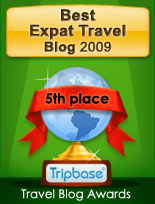We had heard about the half-price nightly specials at Govinda, the restaurant near our flat run by the Hari Krishnas. We decided to check it out.
 Govinda does a nice lunch business.
Govinda does a nice lunch business.Every night from 5:30-6:00 p.m.
they offer what's left on the menu
for half price.
You can click on my title
to go to their web page.
 The smell of incense
The smell of incensewafts out from the gift shop.
It's a good thing we arrived at 5:25
because every single table filled up quickly.
Diners go up to the counter to pick up their food.
We didn't have to select what to eat.
This was a good thing, because we had no idea
what it was. After we started eating it became clear.
 You don't have to sit at a table.
You don't have to sit at a table.These three Hari Krishna ladies enjoyed
the lower tables with floor cushions.
The clay on their noses
is from the Ganges River.
They wear it to signify that
they recognize their bodies as
spiritual temples
not just physical
flesh and blood.
A Hari Krishna lady had confided in me
weeks before in the bakery that the best thing
about these outfits is they hide
every possible figure flaw.
 Inside the gift shop and cultural center
Inside the gift shop and cultural centerThis encounter, so far, hadn't been anything like that. After dinner, Marcello had to head out to English class. I had time to pop into the gift shop and cultural center. Lo and behold, a program was about to begin. Being an empty nester, I didn't have to be somewhere at a certain time. I could be spontaneous and stay! And having no fear at this age in life that I would "run off and join the Hari Krishnas" staying to learn more about their life seemed more interesting than threatening.
Every Wednesday night, after the restaurant closes at 6 p.m., the Hari Krishnas hold a congregational chant. Tonight was going to be even more informative, because a young man who graduated from a Hari Krishna all-male secondary school in India was going to give a slide presentation on the school. I was lucky to sit down next to a very nice young woman named Christine who offered to translate and explain everything to me.
I love singing. It's 100% non-cynical. I have done solitary meditation but this was going to be my first group meditation or chanting. The room was standing room only with approximately 70 people in it wearing a mixture of saris, regular Western casual clothes, and even one suit and tie. Many people came straight from work.
The chant was led by three men. The chant leader played the harmonium, another man and Christine rhythmically clanged finger cymbals, and the young man who would the evening's speaker played a drum that reminded me of a conga drum.
It was beautiful. The entire room focused on the chant and it truly was like a transcendental spiritual vibration could be felt. The number of people, the rhythm, the sounds of the drums, keyboards, and clanging cymbals all added up to a sum greater than it's parts. The leader later told me that doing it together is what helps prevent boredom and mind flicker (what the Buddhists call "monkey mind.")
 Before the program began
Before the program beganThe speaker's English was "native" because so many Americans and Aussies attend the school. He said the boys were raised with austerity and taught to be celibate until age 25. If they reach 25 without breaking their celibacy, they have a good chance of making it as a good "householder." He said "you only have to look out in society to see what happens when the boy doesn't keep this celibacy. He will never keep it and he will likely be part of regular society's 50% divorce rate."
I had asked Christine why there were so many men there that night and she told me the Hari Krishna movement is about 2/3 male. She has no idea why. We giggled about the odds.
The young man didn't have pictures of the girl's school. He said it was not as austere as the boy's school since girls are more tenderhearted and needed to be raised with more opulence (who can disagree with that???).
When he asked who in the audience would like to send their children to his school, about 5-10 people raised their hand. I didn't feel an ounce of proselytizing that night. The people in the audience seemed like regular people.











































 Who links to me?
Who links to me?
